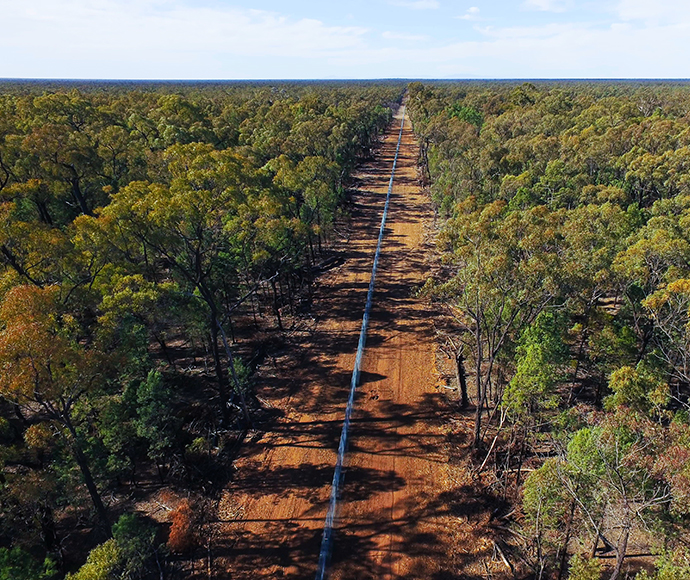Australia’s “Easter Bunny” enjoying life in the Pilliga
Kristin Murdock
11 May 2024, 7:40 AM
 Australia Wildlife Conservancy ecologists are encountering more juvenile bilbies during their 2024 surveys. (Image: Tim Henderson, AWC)
Australia Wildlife Conservancy ecologists are encountering more juvenile bilbies during their 2024 surveys. (Image: Tim Henderson, AWC)The greater bilby is one of Australia’s iconic marsupials and was once widespread throughout arid and semi-arid Australia, including NSW.
Due to habitat loss and introduced predators and herbivores, the greater bilby has been locally extinct in NSW for more than a century. The last record of bilbies in the wild in NSW was near Wagga Wagga in 1912.
In an attempt to reestablish local communities, the Australian Wildlife Conservancy moved bilbies to semi-arid climate of the Pilliga in late 2018.
Their Pilliga project area covers about 35,632 hectares at the northern, more productive section of the Pilliga forests and stretches across the flat, sandy plains and low hills between the Warrumbungle Mountains, near Coonabarabran, and Narrabri.
The effort to relocate the tiny marsupials was huge. It involved catching the animals at Scotia Wildlife Sanctuary, which is located south of Broken Hill and transporting them on a chartered flight to Narrabri, where air-conditioned vehicles were waiting, fitting them with GPS-enabled radio transmitters, and releasing them after dark into the Pilliga.
It was anticipated that in a few years’ time the Pilliga would be supporting a population of 850 bilbies.
While these two populations have increased over time and are estimated at 175 individuals in the Pilliga (2023 census) and 116 individuals in Mallee Cliffs (2022 census), they have not reached the population numbers as hoped.
However, signs are positive as since the 2023 census, the Pilliga bilbies have dispersed from the smaller breeding area into the wider fenced area.

The Australian Wildlife Conservancy's protection zone for reintroducing threatened species into the Pilliga forest is well-fenced and monitored. IMAGE: AWC
Ecologists reported in March that they have also witnessing a burrowing frenzy in the last 12 months.
The prolific foragers and diggers play an important role as ecosystem engineers, turning over 20 tonnes of soil annually through burrowing and digging for food. Their digging improves water infiltration and creates fertile microhabitats where plant seeds can germinate.
“The bilbies with their engineering colleagues, the bettongs, have turned over a lot of soil in their search for food and when digging burrows,” said Senior Wildlife Ecologist, Dr Vicki Stokes. “These activities will improve the ecosystem health of the Pilliga forest over time.”
During the most recent population survey in the Pilliga, Dr Stokes and her team encountered several baby bilbies.
“Two of the female bilbies had tiny baby bilbies, called joeys, in their pouches. We’ve also had increasing bilby activity on motion-sensor cameras across the fenced area, indicating that the population is doing well.”
UNSW research
As this population grows in the Pilliga, new research is looking at returning the bilby to temperate Australian regions, which was their natural habitat.
University of New South Wales (UNSW) scientists have just released a study about this, based on a population of bilbies in a large sanctuary near Dubbo.
Dr Kate Cornelsen was lead author in the study and her PhD research focused on understanding the habitat preferences and movement patterns of these unique nocturnal marsupials in the Dubbo sanctuary.
She said up until now, very little is known about what bilbies do and need in the temperate zone.
“If bilbies are to be restored in the temperate zone where they once thrived, we need to know much more about where they like to go and what they need there,” Dr Cornelson says.
“We fitted tiny GPS tracking devices to the tails of 20 greater bilbies, which recorded where the bilbies were every hour, giving us a unique insight into their nocturnal habits and preferences in this area. Food biomass or availability essentially had a strong influence on where they preferred to hang out."
“They seemed pretty good at working out where the food was. Interestingly though, they also preferred certain soil types, and females were much pickier in this respect than were males.”

IMAGE: Australian Museum
In general, bilbies spent more time in areas further from water sources in most seasons.
This was a little surprising to the researchers, as areas close to water are likely to be more productive and have more food available. However, in the temperate zone where this study took place, food might not be so limiting to the bilbies.
“Food is probably less patchy and more predictable in this study area compared to the desert where they’ve been studied before,” Dr Cornelsen says. “Areas further from water probably still provide sufficient food for bilbies, and because bilbies get all of the water they need from their food, being further from water might help them avoid competition with other species that do need to drink.”



